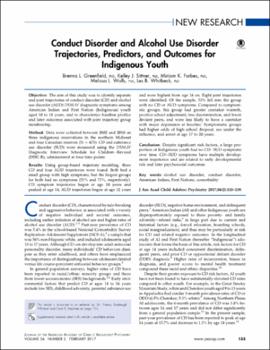| dc.contributor.author | Greenfield, Brenna L. | |
| dc.contributor.author | Sittner, Kelley J. | |
| dc.contributor.author | Forbes, Miriam K. | |
| dc.contributor.author | Walls, Melissa L. | |
| dc.contributor.author | Whitbeck, Les B. | |
| dc.date.accessioned | 2022-02-15T20:43:19Z | |
| dc.date.available | 2022-02-15T20:43:19Z | |
| dc.date.issued | 2017-02 | |
| dc.identifier | oksd_sittner_conductdisorder_2017 | |
| dc.identifier.citation | Greenfield, B. L., Sittner, K. J., Forbes, M. K., Walls, M. L., & Whitbeck, L. B. (2017). Conduct disorder and alcohol use disorder trajectories, predictors, and outcomes for Indigenous youth. Journal of the American Academy of Child and Adolescent Psychiatry, 56(2), pp. 133-139. https://doi.org/10.1016/j.jaac.2016.11.009 | |
| dc.identifier.uri | https://hdl.handle.net/11244/334613 | |
| dc.description.abstract | Objective: The aim of this study was to identify separate and joint trajectories of conduct disorder (CD) and alcohol use disorder (AUD) DSM-IV diagnostic symptoms among American Indian and First Nation (Indigenous) youth aged 10 to 18 years, and to characterize baseline profiles and later outcomes associated with joint trajectory group membership. | |
| dc.description.abstract | Method: Data were collected between 2002 and 2010 on three indigenous reservations in the northern Midwest and four Canadian reserves (N = 673). CD and substance use disorder (SUD) were measured using the DSM-IV Diagnostic Interview Schedule for Children-Revised (DISC-R), administered at four time points. | |
| dc.description.abstract | Results: Using group-based trajectory modeling, three CD and four AUD trajectories were found. Both had a small group with high symptoms, but the largest groups for both had no symptoms (55% and 73%, respectively). CD symptom trajectories began at age 10 years and peaked at age 14; AUD trajectories began at age 12 years and were highest from age 16 on. Eight joint trajectories were identified. Of the sample, 53% fell into the group with no CD or AUD symptoms. Compared to symptomatic groups, this group had greater caretaker warmth, positive school adjustment, less discrimination, and fewer deviant peers, and were less likely to have a caretaker with major depression at baseline. Symptomatic groups had higher odds of high school dropout, sex under the influence, and arrest at age 17 to 20 years. | |
| dc.description.abstract | Conclusion: Despite significant risk factors, a large proportion of Indigenous youth had no CD-SUD symptoms over time. CD-SUD symptoms have multiple development trajectories and are related to early developmental risk and later psychosocial outcomes. | |
| dc.format | application/pdf | |
| dc.language | en_US | |
| dc.publisher | Elsevier BV | |
| dc.relation.ispartof | Journal of the American Academy of Child and Adolescent Psychiatry, 56 (2) | |
| dc.relation.uri | https://www.ncbi.nlm.nih.gov/pubmed/28117059 | |
| dc.rights | This material has been previously published. In the Oklahoma State University Library's institutional repository this version is made available through the open access principles and the terms of agreement/consent between the author(s) and the publisher. The permission policy on the use, reproduction or distribution of the material falls under fair use for educational, scholarship, and research purposes. Contact Digital Resources and Discovery Services at lib-dls@okstate.edu or 405-744-9161 for further information. | |
| dc.subject | American Indian | |
| dc.subject | First Nations | |
| dc.subject | alcohol use disorder | |
| dc.subject | comorbidity | |
| dc.subject | conduct disorder | |
| dc.subject.mesh | Adolescent | |
| dc.subject.mesh | Alcoholism | |
| dc.subject.mesh | Canada | |
| dc.subject.mesh | Child | |
| dc.subject.mesh | Conduct Disorder | |
| dc.subject.mesh | Female | |
| dc.subject.mesh | Humans | |
| dc.subject.mesh | Indians, North American | |
| dc.subject.mesh | Juvenile Delinquency | |
| dc.subject.mesh | Longitudinal Studies | |
| dc.subject.mesh | Male | |
| dc.subject.mesh | Midwestern United States | |
| dc.subject.mesh | Sexual Behavior | |
| dc.subject.mesh | Student Dropouts | |
| dc.title | Conduct disorder and alcohol use disorder trajectories, predictors, and outcomes for Indigenous youth | |
| dc.date.updated | 2022-02-09T17:51:52Z | |
| osu.filename | oksd_sittner_conductdisorder_2017.pdf | |
| dc.description.peerreview | Peer reviewed | |
| dc.identifier.doi | 10.1016/j.jaac.2016.11.009 | |
| dc.description.department | Sociology | |
| dc.type.genre | Article | |
| dc.type.material | Text | |
| dc.relation.oaurl | https://pubmed.ncbi.nlm.nih.gov/28117059/ | |
| dc.identifier.author | ORCID: 0000-0003-4173-939X (Greenfield, BL) | |
| dc.identifier.author | ScopusID: 55348927600 (Greenfield, BL) | |
| dc.identifier.author | ORCID: 0000-0002-8588-4487 (Sittner, KJ) | |
| dc.identifier.author | ScopusID: 55189348500 | 57195727690 (Sittner, KJ) | |
| dc.identifier.author | ScopusID: 55206928500 (Forbes, MK) | |
| dc.identifier.author | ScopusID: 14065623300 (Walls, ML) | |
| dc.identifier.author | ScopusID: 35430449600 (Whitbeck, LB) | |
